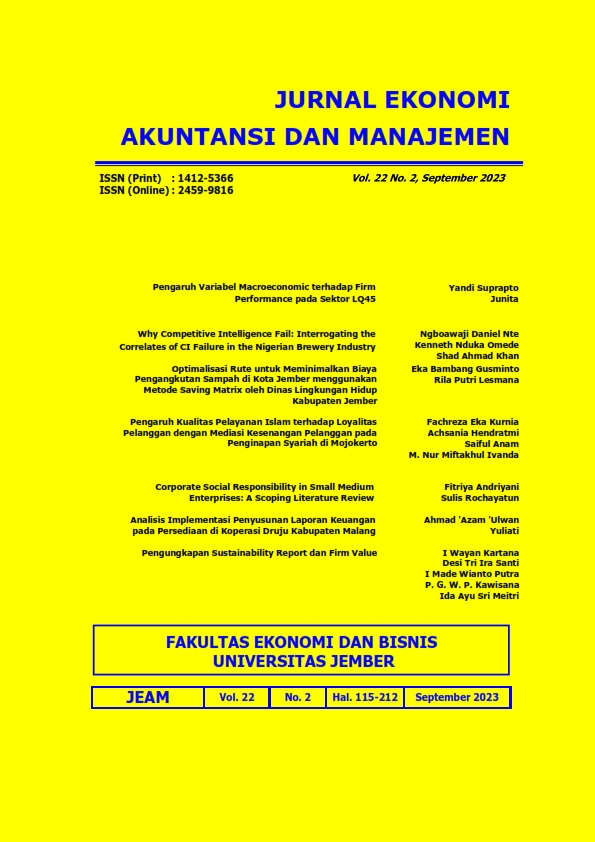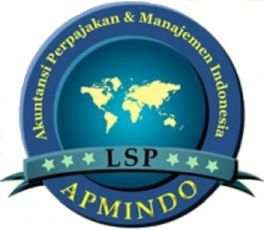Why Competitive Intelligence Fail: Interrogating the Correlates of CI Failure in the Nigerian Brewery Industry
Abstract
Globally, as businesses grapple with uncertainties and challenges of growth and expansion, competitive intelligence failure has remained an obvious reality. This work therefore attempts to evaluate the intervening variables underlying the menace of competitive intelligence failure in the business world. Specifically, the study identifies the factors responsible for CI failures in the brewery industry in Nigeria. The identified factors include; lack of planning and management skills by managers and top company executives, faulty business decision making process and implementation by management and lack of coordinated organisational culture and political climate in the brewery industry in the country. In reaching these analytical premises, the study adopted a quantitative evaluation of some breweries in Nigeria to determine the pattern and trends of the competitive intelligence correlates and offered corresponding recommendations that will help to mitigate the menace of competitive failure in Nigeria.
Key Words: Competitive Intelligence, Correlates, Failure, Nigeria, Brewery Industry
References
Brown, Stephen. 2008. Fail Better!: Stumbling to Success in Sales & Marketing. Cyan Communications.
Chao, Lawrence P, and Kosuke Ishii. 2007. “Design Process Error Proofing: Failure Modes and Effects Analysis of the Design Process.”
Colakoglu, Tanju. 2011. “The Problematic of Competitive Intelligence: How to Evaluate& Develop Competitive Intelligence?” Procedia-Social and Behavioral Sciences 24. Elsevier: 1615–1623.
Fleisher, C.S, and S Wright. 2009. Causes of Competitive Analysis Failure: Understanding and Responding to Problems at the Individual Level, In Third European Competitive Intelligence Symposium. Stockholm: Retrieved from https://www.dora.dmu.ac.uk/bitstream/handle/2086/4518/2009%20-%20EcIs%20Conference%FINAL.pdf?sequence=1.
Gilad, Benjamin. 1994. “Business Blindspots: Replacing Your Company’s Entrenched and Outdated Myths, Beliefs and Assumptions with the Realities of Today’s Markets.” (No Title).
Heuer, Richards J. 2005. “Limits of Intelligence Analysis.” Orbis (Philadelphia) 49 (1). Elsevier Science: 75–94.
Jensen, Mark A. 2012. “Intelligence Failures: What Are They Really and What Do We Do about Them?” Intelligence and National Security 27 (2). Taylor & Francis: 261–282.
Johnson, A R. 2004. “The Top 12 Priorities for Competitive Intelligence.” Retrieved Http://Www-Sop.Inria.Fr/Acacia/WORKSHOPS/ECAI2002-OM/Soumissions/ECAI2002-Johnson-1.Htm. 3: 2007.
Johnston, Rob. 2005. Analytic Culture in the United States Intelligence Community: An Ethnographic Study. Central Intelligence Agency.
Kahaner, Larry. 1998. Competitive Intelligence: How to Gather Analyze and Use Information to Move Your Business to the Top. Simon and Schuster.
Karim, Akram Jalal. 2011. “The Value of Competitive Business Intelligence System (CBIS) to Stimulate Competitiveness in Global Market.” International Journal of Business and Social Science 2 (19). Citeseer.
Krylov, Sergey. 2022. “Competitive Intelligence as a Tool of Modern Competitive Analysis: Review of the Main Methods and Evaluation of the Result.” Available at SSRN 4070381.
Maungwa, Masego Tumelo. 2017. “Competitive Intelligence Failures from the Perspective of Information Behaviour.” University of Pretoria.
Odendaal, Bernardus Johannes. 2006. “Competitive Intelligence with Specific Reference to the Challenges Facing the Competitive Intelligence Professional in South Africa.” University of Pretoria.
Pellissier, Rene, and Tshilidzi E Nenzhelele. 2013. “Towards a Universal Competitive Intelligence Process Model.” South African Journal of Information Management 15 (2). AOSIS: 1–7.
Priporas, Constantinos‐Vasilios, Lampros Gatsoris, and Vassilis Zacharis. 2005. “Competitive Intelligence Activity: Evidence from Greece.” Marketing Intelligence & Planning 23 (7). Emerald Group Publishing Limited: 659–669.
Report, Equity Research. 2006. “Performance Report of Nigerian Breweries from 2001 to 2005.” Retrieved from Www.Meristem,Org.
Report, Equity Research. 2021. “Erformance Report of the Brewery Industry from 2015 to 2020.” Retrieved from Www.Meristem.Org.
Rigby, D.K. 2009. Management Tools 2009: An Executive’s Guide. White Paper. Boston: MA: Brain & Company, Inc.
Rigby, Darrell. 2003. “Management Tools 2003.” Brain & Company, Www. Bain. Com.
Rigby, Darrell K. 2001. “Putting Tools to the Test: Senior Executives Rate 25 Top Management Tools.” Strategy & Leadership 29 (3). MCB UP Ltd: 4–12.
Solovyeva, L. N. 2021. Konkurentnye Preimushchestva i Benchmarking [Competitive Advantages and Benchmarking]. Moscow: Yurayt.
Underwood, Jim. 1995. “Making the Break: From Competitive Analysis to Strategic Intelligence.” Competitive Intelligence Review 6 (1). Wiley Online Library: 15–21.

This work is licensed under a Creative Commons Attribution-ShareAlike 4.0 International License.





